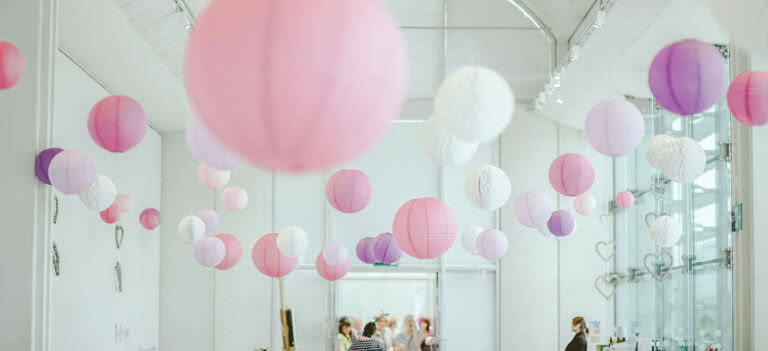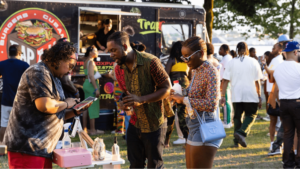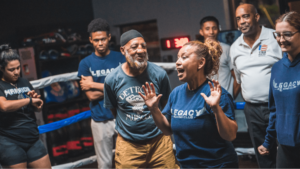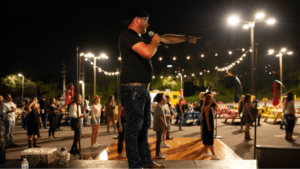The venue you choose and the decor you furnish it with have the power to bring your event or brand to life. Done right, beautiful event design can change the atmosphere of a venue and give your attendees something to talk about — or share on their social media. Without the elements of event design, however, attendees may feel uninspired — or worse, unsatisfied.
Event design is so much more than making your space look nice, though — it’s an art. Want to master it? Here are the eight essential elements of event design you need to know.
Event design element #1: Space
Your venue or location is the canvas upon which your event design will be displayed to maximum effect. Get to know its features and dimensions. Put yourself in your attendees’ shoes and walk around the venue to understand where guests will enter and exit. What will help them feel welcome and get them oriented?
When planning the layout of your space, think about the route you want guests to take. If it’s big and blank, how can you best break it up? It’s about getting the balance right between positive (furnished) and negative (unfurnished) space, so your event never feels overcrowded.
Event design element #2: Lines
Lines are created by your venue’s architecture and how you furnish it. The right combination of line can alter your attendees’ perception of your venue, making small spaces feel large and vice versa.
If your lines are out of balance, here’s how you can add more interest:
- Horizontal lines can be added through items such as rugs, tables, and floor tiles
- Vertical lines can be made with drapes, columns, and wall hangings
- Dynamic lines add interest and movement, such as curves and angles
Event design element #3: Forms
A close relative of lines, forms are the shapes created by outlines of any 3D objects in space, such as furniture, furnishings and structures. Forms help to balance the space, but they can also add drama and character. You can include a mix of shapes (circles, squares, and triangles), or choose to focus on a key one (just circles).
Want to play with form? Try these ideas:
- Bring in statement pieces: You can play with form by bringing in statement pieces such as unusually or boldly shaped furniture or sculptures.
- Play with proportion: Adjusting the scale of objects can create a big impact. For example, an imposing entrance arch can transport attendees from the outside world and immerse them in the event experience.
- Recreate larger-than-life everyday objects: Another way to grab your attendees’ attention with scale is by recreating an everyday object, such as a spoon, in giant size. Because it’s unexpected it instantly becomes a focal point.
Event design element #4: Light
Not only is light a key element to good event design, it can also influence the how attendees perceive your event space. Through lighting alone, you can direct focus to different areas, make vertical columns, or project a horizontal path through a room.
Mood or atmosphere is also heavily influenced by lighting, so it’s important to spend time getting it right. For daytime events, try to choose a venue with good natural lighting. For nighttime events, play around with colors and brightness.
Other ways to experiment with light:
- Uplighters: Lights positioned upwards to cast light on walls and columns
- Gobos: Lights with patterned stencils
- Pin/spotlights: Lights that focus on specific objects
- Washlights: Lights that “paint” your space with color
- LED strip lights: Thin strips of lights that can be bent into different shapes
- LED furniture: Illuminating bars, podiums, and tables that stand out from the ordinary
Event design element #5: Color
Another way to set the right tone in your space is by picking the right color palette. For example, if you want attendees to focus and learn, go for greens or blues. Looking for creativity? Think inspirational hot pink and orange.
Make sure to use color to your advantage throughout your event by:
- Incorporating color in key elements such as decorations, lighting and printed materials like signage and menus
- Playing with different hues of your core colors to add interest to your aesthetic while maintaining a cohesive look
- Using accent colors to add interest and avoid going overboard
Event design element #6: Texture
Don’t neglect to engage your attendees’ sense of touch in your designs. Texture plays a big role in how people will engage physically with your event. A bouncy, rubber floor, for example, will invite attendees to jump on it. A fluffy wall will inevitably be stroked. And an ice statue might be tentatively poked.
You also want to consider how the materials you’re choosing will look. Aim for an interesting mix of natural and manmade.
In addition to actual texture (where the texture is both seen and felt), there’s also visual texture (imagine brick-printed wallpaper). Both can enhance the sensory experience.
Event design element #7: Pattern
Like texture, patterns add interest to your event design. But before you cover your venue’s walls in full animal print, consider a subtler way of incorporating patterns into your event design. Your core colors, for example, can be combined to create patterns throughout your space in a less dominating way.
Patterns can also break up an otherwise bland space. Whether it’s florals, geometric, stripes, or motifs, the patterns you choose should balance each other. Otherwise, you might risk giving attendees a headache!
Event design element #8: Plants
Greenery and plant life are powerful mood boosters. In fact, they’ve been proven to reduce stress and even improve concentration.
As a design element, plants can be a useful tool in helping you achieve your visual goals. Plus, they come in a wide variety of shapes, sizes, and colors.
There are many ways you can incorporate plants into your event design, including:
- Hanging plants
- Living backdrops or walls
- Centerpieces
Creating a unique experience that stands the test of time
Discover the three stages of crafting an experience that will make attendees come back year after year in our guide, How to Craft the Ultimate Event Experience.





